9th January 2008
 Wednesday, January 9, 2008 at 10:10AM
Wednesday, January 9, 2008 at 10:10AM Yesterday, we went for sundowners with our friends on this beautiful great big rock on the edge of the Yatta Plateau. It meant crossing the Athi River which can be tricky. There is a rudimentary concrete causeway, which fills in areas between natural lines of rocks, but if you don’t know the exact route, with its kinks and unexpected turns, you can easily end up in the drink, as it were!
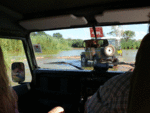
River crossing (click to enlarge any image)
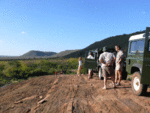
Sundowner Rock on the Yatta
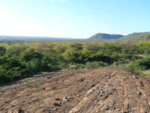
The view stretching for miles...
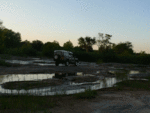
Back across the river at sundown
Once across the river, we followed the road along the edge of the river (catching a glimpse of our house from a new angle - we were pleased to see how well it blended in with the natural landscape), and then we turned up a small overgrown track towards our "sundowner rock". The bush was so dense, Ian had to get out of the car on several occasions to recce the best way through the thickets. We were essentially following an age-old elephant trail, which leads to the spring at the base of the rock. This is how many roads are built in the national parks – they follow the elephant trails. Year on year, elephants use the same paths, all leading to specific watering points or types of vegetation which the elephants like – and because elephants inevitably find the best way up and over hills, or through rocky landscape, it makes sense for any new human road to follow their well established routes.
The view from the top of the rock was awesome – a sea of bushland stretching away for miles and miles. Mount Kilimanjaro was just visible through the heat haze on the horizon. The vegetation up there on the side of the Yatta was still predominantly green from the rains, although the commiphora trees are turning yellow so quickly now, interspersing the bushland with rich yellows which remind you of autumn colours in colder climes. The smell of the wild sage was all around us as we navigated through the thick bush on the way home, some of the leaves being crushed under wheel…it reminded me of the wild sage stuffing we made for our Christmas turkey!
We’ve had some new bird sightings around the house in the past few days. I saw an African Hoopoe on January 6th, but did not manage to photograph it, as it was on the road and flew away as we came around the corner. These Hoopoes are the most beautiful brids, with bright chestnut fathers contrasting with black and white, and a long scimitar-like bill, and a spectacular crest, which they can erect at will.
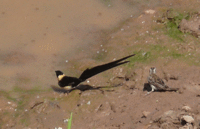
Paradise Whydah pair (male on the left)
click to enlarge
Talking of spectacular birds, the Paradise Whydahs have arrived, no doubt attracted in no small measure to the seeding grasses on our Hippo Lawn. In breeding plumage, the male bird is quite the Beau Brumel of the bush…with his long black tail and golden yellow collar. The female, in stark comparison, is brown and nondescript to look at…
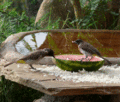
Bulbuls at the bird table
click any image to enlarge
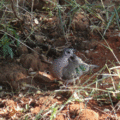
Emerald-spotted Wood Dove on our Hippo Lawn

Grey-headed Sparrow at birdbath
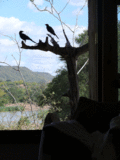
Glossy Starlings outside our bedroom

Fledgling Village Weaver with Adult Male
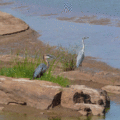
Goliath Heron (left) and Grey Heron
The Hippo Lawn continues to attract seed-eaters of all kinds, from the squirrels to the doves, and the little Waxbills – the Cordon Bleus, the Fire Finches and the Indigo Birds too. The bird table too remains popular – the Village Weavers are still bringing their fledglings to feed there, the Bulbuls are delighted with all the fruit scraps I put out for them, the Sparrows grab what they can when they can, and the Glossy Starlings - as ever - rule the roost. I think these large and bullying birds may be putting off some of the other species from coming, like the smaller Superb Starlings who are normally the first to colonise a bird table in this part of the world. Or perhaps it’s just that the other species are still getting used to having us around.
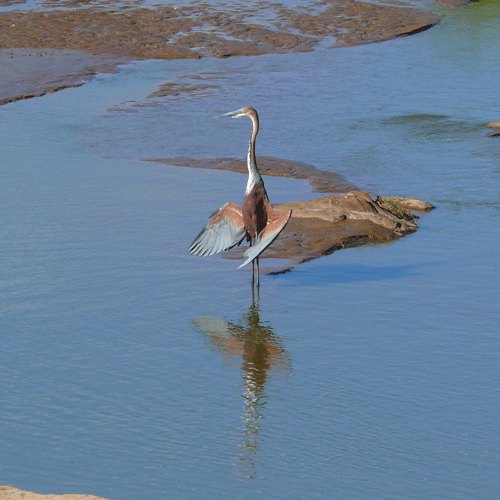
The smaller, though no less elegant, Grey Heron was there too. It’s easy not to be as impressed by him, for he is here every day, but he is in fact no less beautiful. The other day, I watched as he swooped low over the water, in strange circular patterns, forwards and back…and yesterday, I saw two Egrets doing exactly the same thing – it must be a form of display that these birds do. I’ve never seen it before.
There are more and more antelope coming back to the river, as the bushland starts to dry out. We see at least three different groups of Waterbuck each day (one of which is often spotted on our Little Serengeti), as well as several Impala herds. We regularly see the Impala with the Baboon troop on the river’s edge in the early mornings and late evenings. The Impala feel safe from predators near the sharp-eyed Baboons, using them as their lookouts.
So, although it seems quite quiet on the river at the moment, there is in fact always a lot going on, and all sorts of different creatures playing out their lives here all around us.
I spent a delightful fifteen minutes with some vibrant orange butterflies, which were feeding on a heliotropium shrub near the river’s edge. There were three butterflies, all on the same bush, and they looked absolutely gorgeous in the late evening light.
A pair of Lesser Striped Swallows seems intent on building their mud nest on the light above the mirror in our bathroom. One of the pair has discovered the mirror, and spends hours sitting on the ledge next to our soap dish, looking at itself and no doubt wondering where on earth this other swallow has come from!
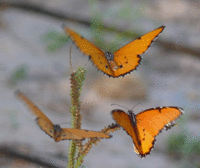
Flight of the orange butterflies...
click to enlarge any image
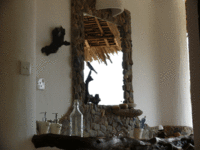
Swallow looking at itself in the bathroom mirror
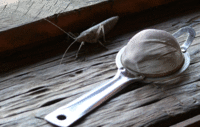
I called this the "Shrimp Bug" and placed the tea strainer next to it for scale!

"Shrimp Bug" in close-up
In Pictures:
More January Birds, including the Goliath Heron, Grey Heron, Whydahs, Waxbills, Weavers, plus other avian visitors to our birdbath and riverbank...
Our Life in the Wild: crossing the river to have sundowners on the Yatta Plateau, our unusual running route...and more...
Our beautiful "Flintstonesque" Kulafumbi home: the house in all its unconventional glory...
More January Insects: from fabulous butterflies to bizarre "shrimp bugs"...
 Tanya
Tanya
1.30pm:
We’ve just been watching "our" Egyptian Goose family – two goslings back in tow but obviously not too popular with their parents – chase off a little crocodile. The geese were headed for a small sand island, and the crocodile was in the way. For a few moments, all familial disputes were forgotten while the common enemy was dealt with, and as a group they managed to herd the crocodile away. As soon as the crocodile retreated, the parents once again concentrated on ensuring their offspring no longer felt welcome in their presence. Whenever the almost-adult goslings got too close, one or both of the parents would chase them away. Imagine how confused the goslings must be feeling: up until now, all they have known is the selfless protection of their parents; now those same parents are chasing them away, as if to say, “Go on, get out of here, get your own life”. The youngsters are obviously gradually getting used to the big wide world, as we often see the parents on their own, without any offspring in tow, and then all of sudden one, or two, or three goslings will appear again. For us, watching the family dynamics as outsiders, it seems quite sad that each time we see the large goslings could be the last, for it won’t be long now until they are completely independent, and will fly off to find their own stretch of river, away from our little patch. After all, we too have watched them grow from tiny balls of fluff to adult-sized birds, capable of looking after themselves…
Chasing away the crocodile...
...followed by chasing away the kids...
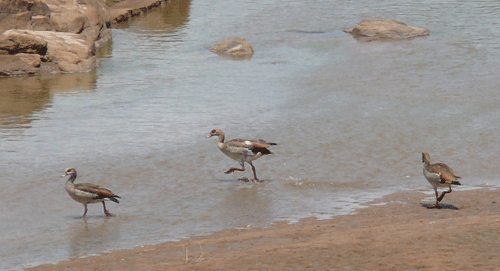
 Tanya
Tanya
Thought I'd tag this on here, as I was talking about Paradise Whydahs in this post...here's a tail feather I found lying on the Little Serengeti...
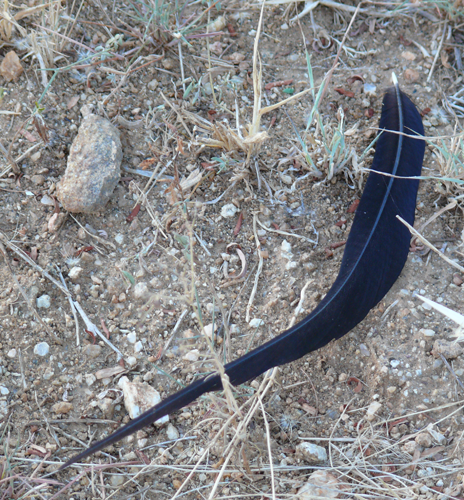





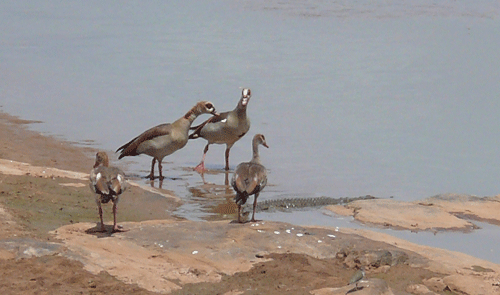
Reader Comments (2)
Tanya:
Thanks for the comments on my blog.
Nairobi must have been somewhat of an adventure.
Some great shots in this post.
But, I got the biggest kick out of, a somewhat younger, Simon holding you as a baby! What a childhood!
Am in Monterey, California now. Incredibly beautiful!
I don't believe the Garden of Eden was lost. It is still right here if one but opens his/her eyes.
Best,
Kinsey
Believe it or not, Nairobi was absolutely quiet (you wouldn't believe it from reading the press reports, would you? The crazy thing about Kenya at the moment is that everyone - bar the politicians - just want to get on with life. There is a growing feeling of anger and resentment towards the politicians who are the only ones who continue to stir up tensions, with no regard for the lives of ordinary Kenyans or indeed for the international reputation of Kenya, which is suffering hugely as a result of all the negative publicity. With international tourism being the second largest revenue earning industry in this country, there are no prizes for guessing what will happen to the Kenyan economy as a result of its demise in the eyes of the world...and all because of the selfish ambitions of two men. Between the politicians and the over-sensationalizing media, they've done a great job of destroying the reputation of an entire country. I'm trying not to get too political in this blog, as it's really about the wilderness and not at all about people and all our foibles, but for anyone who is interested in reading a little more about what Kenyans themselves are feeling, here is an article which is being anonymously circulated around Kenya, but which (in my opinion) speaks for the majority who have lost all faith in their so called leaders.
[Article: Are These Really The Leaders We Want?]